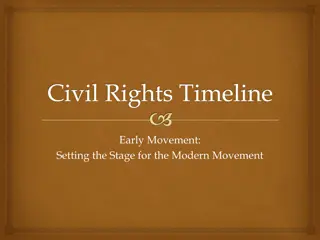The Antebellum South: Economic Disparities and Slavery's Role
The economic disparities between the North and South in the antebellum period are highlighted, with the South lagging in modernization, education, and industrial development. Slavery became a crucial aspect of the Southern economy, particularly in the cotton industry where slaves were essential due to the lack of modernized techniques. The South's dependence on agriculture, specifically cotton, shaped its economic and social structure, leading to tensions with the industrially advancing North.
Download Presentation

Please find below an Image/Link to download the presentation.
The content on the website is provided AS IS for your information and personal use only. It may not be sold, licensed, or shared on other websites without obtaining consent from the author. Download presentation by click this link. If you encounter any issues during the download, it is possible that the publisher has removed the file from their server.
E N D
Presentation Transcript
Chapter 2: The Antebellum South Luke Keister
The Southern Economy Pg.27-29 The South did not modernize Agriculture was very labor intensive Agricultural technology did not modernize from 1800-1860 South did not take to education and had very little commitment to education Almost half the southern population was illiterate
The Southern Economy Pg.27-29 North Modernized greatly North had voluntary associations North had reform movements North had self improvement societies
The Southern Economy Pg.27-29 The South valued tradition and stability The North hurtled toward a future of competitive, meritocratic, free labor capitalism The South responded with distaste and alarm Southern separatism was rooted in resistance to this Northern vision of what America should become (pg.27)
The South as a Colonial Economy Pg.29-34 The South had four fifths of all colonial exports before 1776 Whitney s Cotton Gin made large cotton plantations feasible The North s textile industry made a much greater demand for cotton
My thoughts This made slaves a necessity for the growth of cotton, due to the fact that the south had no modernized machines or methods for planting, growing, and harvesting cotton Slaves were the only option for the production and harvesting of cotton Class thoughts on this point
The South as a Colonial Economy Pg.29-34 The Southern output of cotton doubled every decade from 1800-1860 Cotton was more then half of all America s exports from 1815-1860 Plantations were very profitable, but much of the money made want to outsiders The South had an economic relationship with the North and Great Britain
The South as a Colonial Economy Pg.29-34 At present, the North fattens and grows rich upon the South declared an Alabama newspaper in 1851 (pg. 30) Southern economy grew but did not develop The South did not make a sustainable middle class, therefore not developing a diversified economy
The South as a Colonial Economy Pg.29-34 Southern per capita wealth for free southerners in 1860 ($3,978) Northern per capita wealth in 1860 ($2,040) When slaves are included in the per capita wealth for the South, the South is 27% less then the North South believes slaves are improvements, the more slaves the better
Slavery in the American South Pg. 35-36 Slave labor in the 1850 s 10% in mining, transportation, construction, lumbering, and industry 15% in domestic servants or other non agriculture related labor 75% in agriculture 55% in cotton 10% in tobacco 10% in sugar, rice or hemp
Herrenvolk Democracy Pg. 36-38 Slavery was not only a system of labor exploitation, it was also a method of racial control (Pg. 37) However much some nonslaveholders may have disliked slavery, few could see any alternative to means of preserving white supremacy (Pg. 37) People believed that slavery was wrong, but equality wasn t right
Herrenvolk Democracy Pg. 36-38 The sociologist Pierre L. Van den Berghe has described this rationalization for slaver and white supremacy as Herrenvolk Democracy - the equal superiority of all who belong to the Herrenvolk (master race) over all who did not (Pg. 37) This appeals to both the North and the South
Herrenvolk Democracy Pg. 36-38 Whites=Whites Blacks=Blacks Jacksonian democrats advertized this This advertisement attracted Butternuts, Irish and unskilled laborers from the North to the Democratic party
Herrenvolk Democracy Pg. 36-38 Slavery is the poor man s best government wrote Governor Joseph E. Brown of Georgia (Pg. 38) Slavery was for many whites the foundation of liberty and equality (Pg. 38)
The Conditions of Slavery Pg.38-41 For the slaves, there was no paradox: slavery was slavery, and freedom was the opposite (Pg.38) Chattel bondage gave the master great power over the slaves to buy or sell, to punish without sanction of the courts, to separate families, to exploit sexually, even to kill with little fear of being held legally responsible. As a form of property, the slaves had few human rights in the eyes of the law (Pg.38)
The Conditions of Slavery Pg.38-41 Blacks have many restrictions, and being free is hardly any better then being enslaved Slaves spoke the same language and worshiped the same God as their masters Slaves died quickly in the early stages of slavery U.S. slave population increased an average of 27% per decade after 1810, which is almost the same as natural whites
The Conditions of Slavery Pg.38-41 From 1820 on the sex ratio among slaves was virtually equal, in turn there were less large scale revolts in the U.S. then in Latin America where there were more men then women Slave owners broke up slave families very frequently
Slavery and the Work Ethic Pg.41- 42 Slaves can not move up the social ladder Slaves did slipshod work Slaves were inefficient Whites were able to accomplish twice as much work then a slave in the same amount of time Slaves were careless Slaves caused a technology lag in Southern agriculture
Slavery and the Work Ethic Pg.41- 42 Slaves were careless with and regularly abused the animals Slaves used mules, because mules were able to withstand the abuse better then horses 90% of slaves were illiterate South had a low literacy rate compared to the North Abolitionists said the South had a backwardness about it and slavery was immortal























